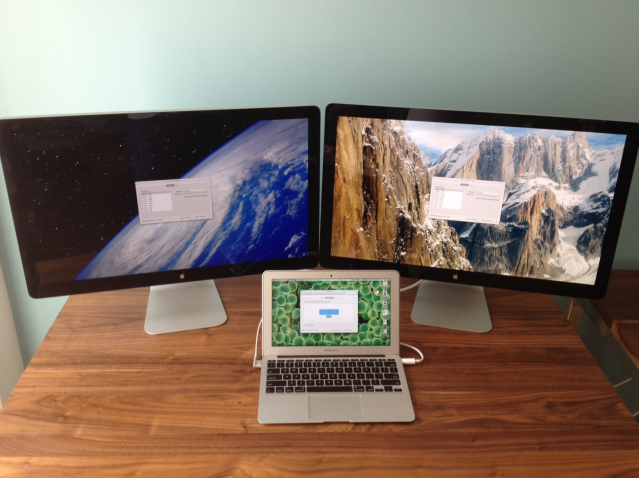I had to shuffle my current desktop;re-arrange monitors and I was reminded of an old subject : displayport/thunderbolt vs HDMI. This subject has been heated debate among tech friends.
This week, I am running full HD/1080p (1920x1080), WQHD (2560x1440) , and WQXGA (2560x1600) off an 27" iMac. I could run another WQHD(Apple 27" Cinema display) through daisy chaining if my desk had enough room to support it.
In short, I have a desktop of 7,040 x 4,120 pixels.
I posted earlier an image of the Retina Macbook Pro displaying 14 million pixels off four displays . That is pretty insane and not possible with HDMI.
HDMI connection is never a selling point for me. I don't know why it is ever a bragging point on new equipment. Sure, you can plug into your HDTV at home and in some conference rooms LCD TVs.However "most" laptops/computers with HDMI can only output a maximum resolution of 1920x1080 (HD). If you do more than watch videos in HD 16x9, HDMI in its shipping form is very limited.
When I shop for a new computer/graphics card, I always choose DisplayPort and mini-DisplayPort/mDP over HDMI. Thunderbolt use the same connector as mDP (mini-DisplayPort).
I hear if you advocate mDP or thunderbolt over HDMI that you are an Apple fanboy. The main argument is that mDP/Thunderbolt is considered proprietary or some silly notion that Apple has to do something different than the rest of the industry. This has been one of the major talking point against getting an Apple Macbook/Air.
Well, if it is considered proprietary, it allows me to drive multiple WQHD (2560x1440) or WQXGA (2560x1600) high resolution monitors. Heck, it allows me to at least drive one WQXGA 30" monitor.
Apple announced mDP in 2008 and has since licensed it for others to use (e.g. Lenovo Thinkpads X1/X230). Thunderbolt is an Intel invention and it is licensed to whoever (Lenovo/Acer/Dell) whats to use it. mDP/Thunderbolt is simply better for the needs of a computer user versus a person who is only interested in hooking up their notebooks to their living room TVs.
Sure, HDMI 1.4 promises to fix the resolution deficiency but the fact remains many monitors with WQHD (2560x1440) or WQXGA (2560x1600) handicap their HDMI input; meaning you will only get 1080p res on that nice Dell U2711 or U3011.
When more WQHD monitors support higher res through HDMI and when laptop manufactures clearly specify the max output resolution of their HDMI output, I might change my mind.
With companies now making ultrabooks, they should all embrace mDP/Thunderbolt.
I don't understand why companies like Asus ship laptops like the UX31E with mini-hdmi and mini-vga. You still need to carry an adapter/dongle for mini-hdmi/mini-vga so the argument about carrying an extra cable is moot. I'm more inclined to think Asus didn't want to spend any extra money on licensing which would even make their ultra portable even smaller with less ports.
With Displayport/mDP/Thunderbolt, you have dongles for VGA (those old conference room projectors), HDMI (for plasma/LCD TVs), and DVI/Dual-DVI for standard monitors. Heck, most cables only cost $3-$10. Displayport even routes digital audio (just like HDMI) in revision 1.2. If you are going to be making presentations at client's conference room, you would most likely be carrying a HDMI cable already so the extra dongle adds little bulk for the few times you use it.
DisplayPort now allows you to daisy-chain monitors in their spec. Here is an excellent example with 2 displays daisy chained. Have in mind, these are two WQHD display running off a Macbook Air. Not even the top of the line Thinkpad W530 can do this (unless you use a docking station with certain configurations).
(source: http://arstechnica.com/apple/2012/06/new-macbooks-can-manage-many-many-monitors/)
So there you have it. I like to conclude with my earlier remark, when I am in the market for a new laptop/computer, I will always choose displayport/mDP/Thunderbolt over HDMI.





No comments:
Post a Comment